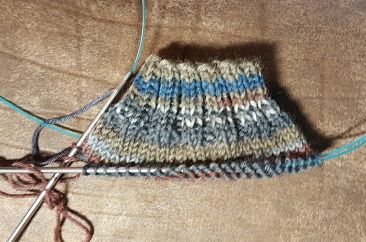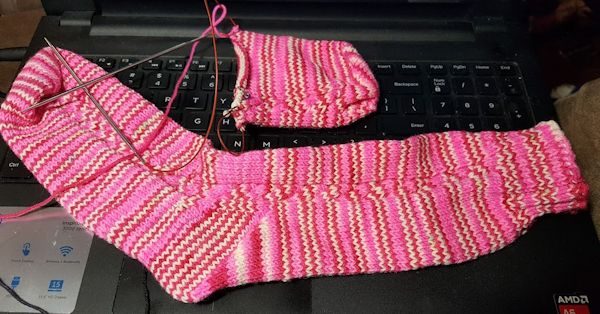There are two basic ways to knit socks. The “first”, simply because it’s the way I learned, is called “cuff down” or “top down”. As it sounds, the sock starts at the cuff. The appropriate number of stitches are cast on, usually some amount of ribbing is done, then the leg, which can be plain stockinette or a pattern, then the heel flap, the heel is turned, the gusset, the instep, the sole and the toe. Knitty has a great diagram here. It is advantageous to know the anatomy of a sock if you’re going to try to knit one.
The second method of knitting a sock is toe up. As you might guess, you start with the toe and basically knit up towards the cuff so for those who are accustomed to knitting top down, it may seem backwards.
Since top down is the way I learned to knit socks, this is the way I’ve preferred to knit socks for years and years. There are advantages and potential disadvantages to both methods of knitting socks. Craftsy has an article discussing some of the advantages and disadvantages here. Lately, I’ve become a fan of knitting toe up socks for one reason: When knitting socks, the leg can be as long or as short as you want to make it but the foot has to be a certain length if you want the sock to fit properly. Most, if not all of the time, I have one skein of yarn, which is sufficient for a pair of socks to fit most feet (men as well as women so long as it isn’t a really long foot). But, if I want to make the leg longer, I don’t want to run short on yarn before the foot is finished and I certainly don’t want to finish one sock and not have enough yarn to finish the second sock.
Lately, I’ve been dividing each skein into two balls of yarn which are equal in weight. It takes a little more time but it takes the guess work out of how long to make the leg of the sock and takes away the concern of running out of yarn. In some instances, since the foot is made first, if I see I’m going to have plenty of yarn left, I can make the leg a bit shorter and end up with enough yarn to make a pair of socks for Addie.
Once the sock is finished, there should not be any noticeable differences in a sock which was knitted cuff down or a toe up sock.
I have knitted so many cuff down socks that I can do them without a pattern. I still have to follow a pattern when knitting toe up so any time I am knitting a sock and don’t want to drag along a pattern, I will still knit cuff down . . at least until I have committed the instructions to memory.



carol fun says
I see the advantages of toe up but I learned cuff down and like you I can knit cuff down socks from memory. Most of my sock knitting is done waiting for others or “watching” tv so I keep doing cuff down cause I don’t have to think,
Michelle says
I suppose “not having to count as many stitches when you cast on” isn’t the best reason for choosing toe up socks whenever possible, huh?
Jeanne Bishop says
Have you seen the Universal Toe-up Sock on Knitty? It uses percentages. I’ve combines that with the Fleegle Heel pattern and never use a pattern for toe up socks unless I want to. I’ve been using the Fleegle heel for so long that I’d have to refer to my instruction books to refresh my mind on how to do any other kind. They’re very easy and fit extremely well.
jatshaw says
i prefer cuff down because I find the toe up cast-on difficult and the cast-off hard to make loose enough to look nice.
Dar in MO says
I learned top down, because my teacher was Judy L. 🙂 I still love doing socks this way. I wanted to learn the toe up just because of the reason you mentioned — longer legs and not having to worry about not enough yarn for the 2nd sock. One day I’ll try the toe up, but for now, my top down socks fit great!! Thanks Judy for teaching me a new skill –f sock knitting.